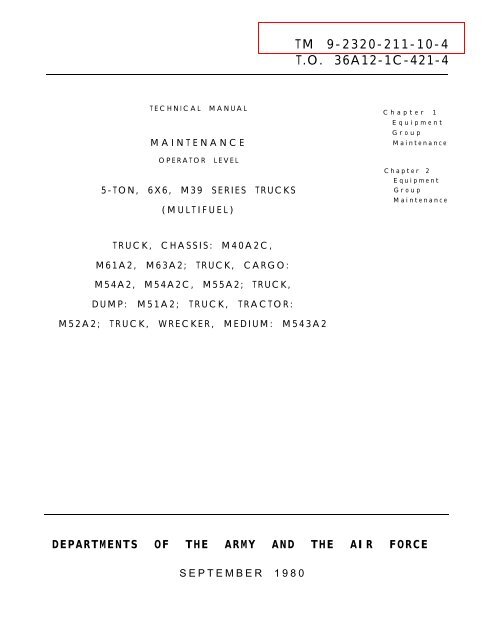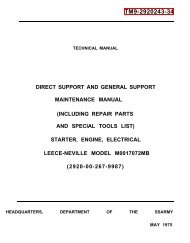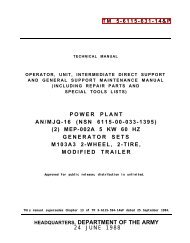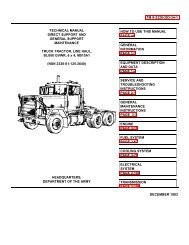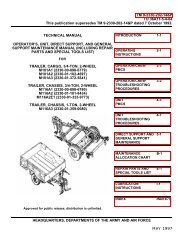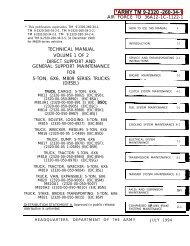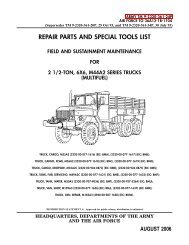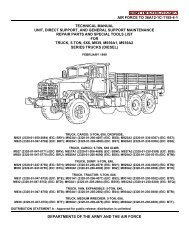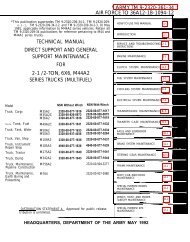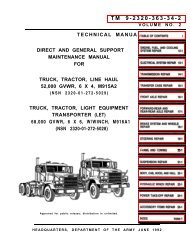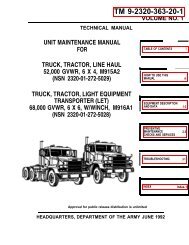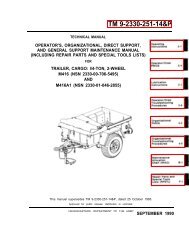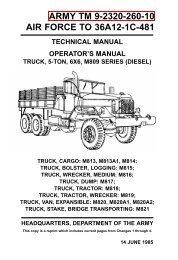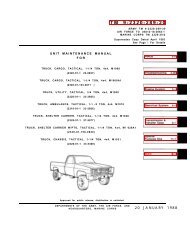TM 9-2320-211-10-4 T.O. 36A12-1C-421-4
TM 9-2320-211-10-4 T.O. 36A12-1C-421-4
TM 9-2320-211-10-4 T.O. 36A12-1C-421-4
Create successful ePaper yourself
Turn your PDF publications into a flip-book with our unique Google optimized e-Paper software.
<strong>TM</strong> 9-<strong>2320</strong>-<strong>211</strong>-<strong>10</strong>-4<br />
T.O. <strong>36A12</strong>-<strong>1C</strong>-<strong>421</strong>-4<br />
TECHNICAL MANUAL<br />
MAINTENANCE<br />
OPERATOR LEVEL<br />
5-TON, 6X6, M39 SERIES TRUCKS<br />
(MULTIFUEL)<br />
Chapter 1<br />
Equipment<br />
Group<br />
Maintenance<br />
Chapter 2<br />
Equipment<br />
Group<br />
Maintenance<br />
TRUCK, CHASSIS: M40A2C,<br />
M61A2, M63A2; TRUCK, CARGO:<br />
M54A2, M54A2C, M55A2; TRUCK,<br />
DUMP: M51A2; TRUCK, TRACTOR:<br />
M52A2; TRUCK, WRECKER, MEDIUM: M543A2<br />
DEPAR<strong>TM</strong>ENTS OF THE ARMY AND THE AIR FORCE<br />
SEPTEMBER 1980
WARNING<br />
EXHAUST GASES CAN BE DEADLY<br />
Exposure to exhaust gases produces symptoms of headache, dizziness, loss of muscular<br />
control, apparent drowsiness, and coma. Permanent brain damage or death can result<br />
from severe exposure.<br />
Carbon monoxide occurs in the exhaust fumes of fuel burning heaters and internal<br />
combustion engines, and becomes dangerously concentrated under conditions of inadequate<br />
ventilation. The following precautions must be observed to insure the safety of<br />
personnel whenever fuel burning heater(s) or engine of any vehicle is operated for<br />
maintenance purposes or tactical use.<br />
Do not operate heater of engine of vehicle in an enclosed area unless it is adequately<br />
ventilated.<br />
Do not idle engine for long periods without maintaining adequate ventilation in personnel<br />
compartments.<br />
Do not drive any vehicle with inspection plates or cover plates removed unless<br />
necessary for maintenance purposes.<br />
Be alert at all times during vehicle operation for exhaust odors and exposure symptoms.<br />
If either are present, immediately ventilate personnel compartments. If symptoms<br />
persist, remove affected personnel from vehicle and treat as follows: expose to fresh<br />
air; keep warm; do not permit physical exercise; if necessary, administer artificial<br />
respiration.<br />
If exposed, seek prompt medical attention for possible delayed onset of acute lung<br />
congestion. Administer oxygen if available.<br />
The best defense against exhaust gas poisoning is adequate ventilation.<br />
Use extreme care when removing radiator cap, especially when temperature gage shows<br />
above 180°F.<br />
Always wear leather gloves when handling winch cable never allow cable to slip<br />
through hands. Do not operate winch with less than four turns of cable drum.<br />
Do not drive truck until the low air pressure warning buzzer is silent and the air<br />
pressure gage shows at least 65 PSI. This is the minimum pressure required for safe<br />
braking action.<br />
Do not use hand throttle to drive the vehicle.<br />
Do not park truck with front transmission gearshift lever in gear.<br />
When used to carry flammables, explosives, or other hazardous material, equip truck<br />
with a fire extinguisher.<br />
If your vehicle class number is greater than the bridge class number, your vehicle is<br />
too heavy for the bridge; DO NOT CROSS.
<strong>TM</strong> 9-<strong>2320</strong>-<strong>211</strong>–<strong>10</strong>-4<br />
TO <strong>36A12</strong>-<strong>1C</strong>-<strong>421</strong>-4<br />
C1<br />
CHANGE<br />
NO. 1<br />
HEADQUARTERS<br />
DEPAR<strong>TM</strong>ENTS OF THE ARMY<br />
AND THE AIR FORCE<br />
Washington D.C., 26 February 1992<br />
TECHNICAL MANUAL<br />
SCHEDULED MAINTENANCE<br />
OPERATOR LEVEL<br />
5-TON, 6X6, M39 SERIES TRUCKS<br />
(MULTIFUEL)<br />
TRUCK, CHASSIS: M40A2C,<br />
M61A2, M63A2, TRUCK, CARGO:<br />
M54A2, M54A2C, M55A2: TRUCK,<br />
DUMP: M51A2; TRUCK, TRACTOR:<br />
M52A2; TRUCK, WRECKER, MEDIUM: M543A2<br />
<strong>TM</strong> 9-<strong>2320</strong>-<strong>211</strong>-<strong>10</strong>-4, dated 5 September 1980 is changed as follows:<br />
1. Remove old pages and insert new pages as indicated below.<br />
2. New or changed material is indicated by a vertical bar in the margin of the page.<br />
Remove Pages<br />
Insert Pages<br />
none<br />
b (c blank)<br />
2-7 and 2-8 2-7 and 2-8<br />
2-13 and 2-14 2-13 and 2-14<br />
File this change sheet in front of the publication for reference purposes.<br />
Approved for public release; distribution is unlimited.
By Order of the Secretary of the Army:<br />
Official:<br />
Milton H. Hamilton<br />
GORDON R. SULLIVAN<br />
General, United States Army<br />
Chief of Staff<br />
MILTON H. HAMILTON<br />
Administrative Assistant to the<br />
Secretary of the Army<br />
00505<br />
By Order of the Secretary of the Air Force:<br />
MERRILL A. McPEAK<br />
General, United States Air Force<br />
Chief of Staff<br />
CHARLES C. McDONALD<br />
General, United States Air Force<br />
Commander, Air Force Logistics Command<br />
Distribution:<br />
To be distributed in accordance with DA Form 12-38-E, Block 0509, Operator maintenance<br />
requirements for <strong>TM</strong> 9-<strong>2320</strong>-<strong>211</strong>-<strong>10</strong>-4.
<strong>TM</strong> 9–<strong>2320</strong>–<strong>211</strong>–<strong>10</strong>-4<br />
WARNINGS (CONT)<br />
If NBC exposure is suspected, all air filter media should be handled by personnel wearing protective<br />
equipment. Consult your Unit NBC Officer or NBC NCO for appropriate handling instructions.<br />
Wear safety glasses or goggles when checking batteries. Always check electrolyte level with engine<br />
stopped. Do not smoke or use exposed flame when checking battery, explosive gases are present and<br />
severe injury to personnel can result.<br />
Remove all jewelry such as rings, dog tags, bracelets, etc. If jewelry contacts battery terminal, a direct<br />
short will result in instant heating of tools, causing damage to equipment and injury to personnel.<br />
Change 1<br />
b (c blank)
*<strong>TM</strong> <strong>2320</strong>-<strong>211</strong>-<strong>10</strong>-4<br />
TO <strong>36A12</strong>-<strong>1C</strong>-<strong>421</strong>-4<br />
TECHNICAL MANUAL<br />
DEPAR<strong>TM</strong>ENTS OF THE ARMY<br />
NO. 9-<strong>2320</strong>-<strong>211</strong>-<strong>10</strong>-4 AND<br />
TECHNICAL ORDER<br />
THE AIR FORCE<br />
NO. <strong>36A12</strong>-<strong>1C</strong>-<strong>421</strong>-4 Washington, DC, 5 September 1980<br />
TECHNICAL MANUAL<br />
MAINTENANCE<br />
OPERATOR LEVEL<br />
5-TON, 6X6, M39 SERIES TRUCKS<br />
(MULTIFUEL)<br />
Model<br />
NSN without Winch<br />
NSN with Winch<br />
Chassis M40A2C <strong>2320</strong>-00-969-4114<br />
M61A2 <strong>2320</strong>-00-055-9264<br />
M63A2 <strong>2320</strong>-00-226-6251<br />
Truck, Cargo M54A2 <strong>2320</strong>-00-055-9266<br />
M54A2C <strong>2320</strong>-00-926-0874<br />
M55A2 <strong>2320</strong>-00-073-8476<br />
Truck, Dump M51A2 <strong>2320</strong>-00-055-9262<br />
Truck, Tractor M52A2 <strong>2320</strong>-00-055-9260<br />
<strong>2320</strong>-00-965-0321<br />
<strong>2320</strong>-00-285-3757<br />
<strong>2320</strong>-00-055-9265<br />
<strong>2320</strong>-00-926-0874<br />
<strong>2320</strong>-00-055-9259<br />
<strong>2320</strong>-00-055-9263<br />
<strong>2320</strong>-00-055-9261<br />
Truck, Wrecker, Medium<br />
M543A2<br />
Current as of 25 March 1980.<br />
<strong>2320</strong>-00-055-9258<br />
*This manual, together with <strong>TM</strong> 9-<strong>2320</strong>-<strong>211</strong>-<strong>10</strong>-1, 5 September 1980; -<strong>10</strong>-2,<br />
5 September 1980; and -<strong>10</strong>-4, 5 September 1980 supersedes so much of<br />
<strong>TM</strong> 9-<strong>2320</strong>-<strong>211</strong>-<strong>10</strong>, 20 November 1977 as pertains to multifuel vehicles.
<strong>TM</strong> 9-<strong>2320</strong>-<strong>211</strong>-<strong>10</strong>-4<br />
REPORTING OF ERRORS AND RECOMMENDING IMPROVEMENTS<br />
You can help improve this manual. If you find any mistakes or if you know<br />
of a way to improve the procedure, please let us know. Mail your letter,<br />
DA Form 2028 (Recommended Changes to Publication and Blank Forms), or<br />
DA Form 2028-2 located in the back of this manual direct to: Commander,<br />
U.S. Army Tank Automotive Materiel Readiness Command, ATTN: DRSTA-<br />
MB, Warren, Michigan 48090. A reply will be furnished to you.<br />
CHAPTER 1. GENERAL MAINTENANCE INFORMATION<br />
Scope . . . . . . . . . . . . . . . . . . . .<br />
General Maintenance . . . . . . . . . . . . . .<br />
Cleaning . . . . . . . . . . . . . . . . . . .<br />
Lubricating . . . . . . . . . . . . . . . . . . .<br />
CHAPTER 2. EQUIPMENT GROUP MAINTENANCE<br />
Section I. Scope . . . . . . . . . . . . . . . . . . . . . .<br />
Equipment Items Covered . . . . . . . . . . .<br />
Equipment Items Not Covered . . . . . . . . .<br />
II. Engine Equipment Items Maintenance . . . . . . .<br />
Access to Engine Compartment . . . . . . . . .<br />
Open Hood and Side Panel . . . . . . . . . .<br />
Close Hood and Side Panel . . . . . . . . . .<br />
III. Fuel System Equipment Items Maintenance . . . .<br />
Air Cleaner Element Removal and Replacement . .<br />
Removal . . . . . . . . . . . . . . . . . . .<br />
Replacement . . . . . . . . . . . . . . . . .<br />
IV. Electrical System Equipment Items Maintenance . .<br />
Battery Inspection . . . . . . . . . . . . . . .<br />
V. Wheels Equipment Items Maintenance . . . . . . .<br />
Spare Wheel Removal and Replacement . . . . .<br />
Removal . . . . . . . . . . . . . . . . . . .<br />
Replacement . . . . . . . . . . . . . . . . .<br />
Jacking Procedure . . . . . . . . . . . . . . .<br />
Raising Truck . . . . . . . . . . . . . . . .<br />
Lowering Truck . . . . . . . . . . . . . . .<br />
Inner Rear Wheels Removal and Replacement . .<br />
Preliminary Procedures . . . . . . . . . . . .<br />
Removal . . . . . . . . . . . . . . . . . . .<br />
Replacement . . . . . . . . . . . . . . . . .<br />
Front and Outer Rear Wheels Removal<br />
and Replacement . . . . . . . . . . . . . . .<br />
Preliminary Procedures . . . . . . . . . . . .<br />
Removal . . . . . . . . . . . . . . . . . . .<br />
Replacement . . . . . . . . . . . . . . . . .<br />
Paragraph<br />
1-1<br />
1-2<br />
1-3<br />
1-4<br />
2-1<br />
2-2<br />
2-3<br />
2-3a<br />
2-3b<br />
2-4<br />
2-4a<br />
2-4b<br />
2-5<br />
2-6<br />
2-6a<br />
2-6b<br />
2-7<br />
2-7a<br />
2-7b<br />
2-8<br />
2-8a<br />
2-8b<br />
2-8c<br />
2-9<br />
2-9a<br />
2-9b<br />
2-9c<br />
Page<br />
1-1<br />
1-1<br />
1-1<br />
1-1<br />
2-1<br />
2-1<br />
2-1<br />
2-2<br />
2-2<br />
2-2<br />
2-5<br />
2-8<br />
2-8<br />
2-8<br />
2-<strong>10</strong><br />
2-12<br />
2-12<br />
2-15<br />
2-15<br />
2-15<br />
2-18<br />
2-21<br />
2-21<br />
2-22<br />
2-23<br />
2-23<br />
2-24<br />
2-25<br />
2-27<br />
2-27<br />
2-27<br />
2-30<br />
ii
<strong>TM</strong> 9-<strong>2320</strong>-<strong>211</strong>-<strong>10</strong>-4<br />
Paragraph<br />
Page<br />
Section VI.<br />
Special Purpose Kits Equipment Items<br />
Maintenance . . . . . . . . . . . . . . . . . .<br />
Installation and Removal of Bow and Tarp Kits .<br />
Installation of Bow Assemblies . . . . . . . . .<br />
Installation of End Curtains . . . . . . . . .<br />
Installation of Paulin . . . . . . . . . . . . .<br />
Removal of Paulin . . . . . . . . . . . . . . .<br />
Removal of End Curtains . . . . . . . . . . .<br />
Removal of Bow Assemblies . . . . . . . . . .<br />
2-<strong>10</strong><br />
2-<strong>10</strong>a<br />
2-<strong>10</strong>b<br />
2-<strong>10</strong>c<br />
2-<strong>10</strong>d<br />
2-<strong>10</strong>e<br />
2-<strong>10</strong>f<br />
2-33<br />
2-33<br />
2-33<br />
2-35<br />
2-36<br />
2-39<br />
2-42<br />
2-43<br />
iii
<strong>TM</strong> 9-<strong>2320</strong>-<strong>211</strong>-<strong>10</strong>-4<br />
CHAPTER 1<br />
GENERAL MAINTENANCE INFORMATION<br />
1-1. SCOPE. This volume of the technical manual covers maintenance tasks,<br />
authorized at the operator’s level of maintenance, for the 5-ton, 6 x 6, M39 series<br />
trucks that have multifuel engines. The tasks given in this volume do not include<br />
those maintenance tasks done on a scheduled basis (PMCS).<br />
1-2. GENERAL MAINTENANCE. The following technical manuals have general<br />
maintenance information for this type of equipment. Refer to these manuals if you<br />
need more information.<br />
a. For operation and maintenance in cold weather (0 to -60°F), refer to <strong>TM</strong> 9-243.<br />
b. For deep water fording, refer to <strong>TM</strong> 9-238.<br />
c. For care and use of handtools and measuring<br />
tools, refer to <strong>TM</strong> 9-243.<br />
1-3. CLEANING. General cleaning instructions for this type of equipment are<br />
given in <strong>TM</strong> 9-247.<br />
1-4. LUBRICATING. Refer to LO 9-<strong>2320</strong>-<strong>211</strong>-12 for materials to be used and<br />
instructions for lubrication of the equipment covered in this technical manual.<br />
1-1/(1-2 blank)
<strong>TM</strong> 9-<strong>2320</strong>-<strong>211</strong>-<strong>10</strong>-4<br />
CHAPTER 2<br />
EQUIPMENT GROUP MAINTENANCE<br />
Section I. SCOPE<br />
2-1. EQUIPMENT ITEMS COVERED. This chapter gives equipment maintenance<br />
procedures for which there are authorized corrective maintenance tasks at operator’s<br />
level. Procedures are given in equipment functional groups by sections and include<br />
the following tasks:<br />
Access to Engine Compartment<br />
Air Cleaner Filter Element Removal and Replacement<br />
Battery Inspection<br />
Spare Wheel Removal and Replacement<br />
Jacking Procedure<br />
Inner Rear Wheels Removal and Replacement<br />
Front and Outer Rear Wheels Removal and Replacement<br />
Installation and Removal of Bow and Tarp Kits<br />
2-2. EQUIPMENT ITEMS NOT COVERED. All equipment items for which corrective<br />
maintenance is authorized at operator’s maintenance level are covered in this chapter<br />
except for the Portable Decontaminating Apparatus. Refer to <strong>TM</strong> 3-4230-204-12&P for<br />
operating and maintenance instructions for this equipment.<br />
2-1
<strong>TM</strong> 9-<strong>2320</strong>-<strong>211</strong>-<strong>10</strong>-4<br />
Section II. ENGINE EQUIPMENT ITEMS MAINTENANCE<br />
2-3. ACCESS TO ENGINE COMPAR<strong>TM</strong>ENT.<br />
TOOLS: None<br />
SUPPLIES: None<br />
PERSONNEL: One<br />
EQUIPMENT CONDITION: Truck parked, engine off, handbrake set.<br />
a. Open Hood and Side Panel.<br />
FRAME 1<br />
1. Turn two side panel latches (1) to the up position.<br />
2. Lower left side panel (2).<br />
GO TO FRAME 2<br />
2-2
<strong>TM</strong> 9-<strong>2320</strong>-<strong>211</strong>-<strong>10</strong>-4<br />
FRAME 2<br />
1. Pull up on each hood holddown latch (1) until they clear each hood catch (2).<br />
2. Push and hold in hood latch (3).<br />
3. Lift hood (4) and then let go of hood latch (3).<br />
GO TO FRAME 3<br />
2-3
<strong>TM</strong> 9-<strong>2320</strong>-<strong>211</strong>-<strong>10</strong>-4<br />
FRAME 3<br />
1. Raise hood (1) to position shown.<br />
2. Pull hood support hook (2) out of storage clip (3).<br />
3. Swing hood support hook (2) up and join support hook with latch (4) as shown.<br />
END OF TASK<br />
2-4
<strong>TM</strong> 9-<strong>2320</strong>-<strong>211</strong>-<strong>10</strong>-4<br />
b. Close Hood and Side Panel.<br />
FRAME 1<br />
1. Push back on hood (1) so that latch (2) clears support hook (3).<br />
2. Hold hood (1) and swing support hook (3) down into storage clip (4).<br />
3. Lower hood (l).<br />
GO TO FRAME 2<br />
WARNING<br />
Keep hands and feet clear of hood and body when closing<br />
the hood.<br />
2-5
<strong>TM</strong> 9-<strong>2320</strong>-<strong>211</strong>-<strong>10</strong>-4<br />
FRAME 2<br />
1. Push down on hood (1) to lock hood latch (2).<br />
2. Pull up on each holddown latch (3) and join them to hood catches (4).<br />
GO TO FRAME 3<br />
2-6
<strong>TM</strong> 9-<strong>2320</strong>-<strong>211</strong>-<strong>10</strong>-4<br />
FRAME 3<br />
1. Raise side panel (1).<br />
2. Turn two side panel latches (2) to the down position.<br />
END OF TASK<br />
2-7
<strong>TM</strong> 9–<strong>2320</strong>-<strong>211</strong>–<strong>10</strong>-4<br />
Section III. FUEL SYSTEM EQUIPMENT ITEMS MAINTENANCE<br />
2-4. AIR CLEANER ELEMENT REMOVAL AND REPLACEMENT.<br />
TOOLS: None<br />
SUPPLIES: None<br />
PERSONNEL: One<br />
EQUIPMENT CONDITION: Truck parked, engine off, handbrake set.<br />
a. Removal.<br />
WARNING<br />
If NBC exposure is suspected, all air filter media should<br />
be handled by personnel wearing protective equipment.<br />
Consult your unit NBC Officer or NBC NCO for<br />
appropriate handling or disposal instructions.<br />
FRAME 1<br />
1. Open three latches (1) holding cover (2) to air cleaner housing (3). Take off cover.<br />
GO TO FRAME 2<br />
2–8 Change 1
<strong>TM</strong> 9-<strong>2320</strong>-<strong>211</strong>-<strong>10</strong>-4<br />
FRAME 2<br />
1. Turn locking device (1) to left until it is free of clamps (2). Pull out locking device.<br />
2. Pull air cleaner element (3) from air cleaner housing (4).<br />
END OF TASK<br />
2-9
<strong>TM</strong> 9-<strong>2320</strong>-<strong>211</strong>-<strong>10</strong>-4<br />
b. Replacement.<br />
FRAME 1<br />
1. Place air cleaner element (1) in air cleaner housing (2).<br />
2. Press locking device (3) into air cleaner housing (2).<br />
3. Turn locking device (3) to right until it is locked in clamps (4).<br />
GO TO FRAME 2<br />
2-<strong>10</strong>
<strong>TM</strong> 9-<strong>2320</strong>-<strong>211</strong>-<strong>10</strong>-4<br />
FRAME 2<br />
1. Place cover (1) on air cleaner housing (2).<br />
2. Lock three latches (3).<br />
END OF TASK<br />
2-11
<strong>TM</strong> 9-<strong>2320</strong>-<strong>211</strong>-<strong>10</strong>-4<br />
Section IV. ELECTRICAL SYSTEM EQUIPMENT ITEMS MAINTENANCE<br />
2-5. BATTERY INSPECTION.<br />
TOOLS: 9/16-inch wrench open end (2)<br />
l/2-inch wrench open end (2)<br />
SUPPLIES:<br />
PERSONNEL:<br />
None<br />
One<br />
EQUIPMENT CONDITION: Truck parked, engine off, handbrake set.<br />
FRAME 1<br />
1. Open battery compartment door (1).<br />
2. Loosen two thumbscrews (2) and push two clamps (3) down to clear battery<br />
box (4).<br />
3. Pull battery box (4) out onto running board (5).<br />
GO TO FRAME 2<br />
2-12
<strong>TM</strong> 9–<strong>2320</strong>-<strong>211</strong>–<strong>10</strong>-4<br />
FRAME 2<br />
WARNING<br />
Wear safety glasses or goggles when checking<br />
batteries. Always check electrolyte level with<br />
engine stopped. Do not smoke or use exposed<br />
flame when checking battery; explosive gases are<br />
present and severe injury to personnel can result.<br />
Remove all jewelry such as rings, dog tags, bracelets,<br />
etc. If jewelry contacts battery terminal, a direct<br />
short will result in instant heating of tools, causing<br />
damage to equipment and injury to personnel.<br />
1.<br />
2.<br />
3.<br />
4.<br />
Unscrew and take off 12 battery filler caps (1).<br />
Check the electrolyte level in each cell. Electrolyte level should be to the level/split ring in the<br />
battery filler opening. If fluid is low, fill with distilled water to the level ring. If fluid is boiling,<br />
notify next higher maintenance.<br />
Screw on and tighten 12 battery filler caps (1).<br />
Check tightness of cables (2) to clamps (3) and clamps (2) to terminal posts (4). Tighten connections<br />
if needed.<br />
GO TO FRAME 3<br />
Change 1 2–13
<strong>TM</strong> 9-<strong>2320</strong>-<strong>211</strong>-<strong>10</strong>-4<br />
FRAME 3<br />
1. Push battery box (1) off of running board (2) into battery compartment.<br />
2. Latch two clamps (3) on thumbscrews (4) and tighten thumbscrews.<br />
3. Close battery compartment door (5).<br />
END OF TASK<br />
* U.S. GOVERNMENT PRINTING OFFICE: 1992 – 643-025/ 40190<br />
2-14 PIN: 046783-001
<strong>TM</strong> 9-<strong>2320</strong>-<strong>211</strong>-<strong>10</strong>-4<br />
Section V. WHEELS EQUIPMENT ITEMS MAINTENANCE<br />
2-6. SPARE WHEEL REMOVAL AND REPLACEMENT.<br />
TOOLS: Wheel stud nut wrench and handle<br />
SUPPLIES: None<br />
PERSONNEL: TWO<br />
EQUIPMENT CONDITION: Truck parked, engine off, handbrake set.<br />
a. Removal.<br />
(1) Trucks M54A2 without winch, M54A2C with winch, and M54A2C without<br />
winch.<br />
FRAME 1<br />
Soldier A 1.<br />
Soldier B 2.<br />
Hold spare wheel (1) in place.<br />
Using wheel stud nut wrench and handle, unscrew and take off<br />
two nuts (2).<br />
Soldiers 3. Take off spare wheel (1).<br />
A and B<br />
END OF TASK<br />
2-15
<strong>TM</strong> 9-<strong>2320</strong>-<strong>211</strong>-<strong>10</strong>-4<br />
(2) Trucks M54A2 with winch and M55A2 with winch.<br />
FRAME 1<br />
1. Using wheel stud nut wrench, unscrew and take off two nuts (1),<br />
two washers (2), and one spring (3) from two tire bolts (4).<br />
2. Lift out two tire bolts (4).<br />
Soldiers 3. Slide out spare wheel (5) from carrier (6).<br />
A and B<br />
END OF TASK<br />
2-16
<strong>TM</strong> 9-<strong>2320</strong>-<strong>211</strong>-<strong>10</strong>-4<br />
(3) Truck M51A2.<br />
FRAME 1<br />
Soldier A 1.<br />
Hold spare wheel clamp assembly (1) so it does not fall.<br />
Soldier B 2. Using wheel stud nut wrench, unscrew and take off nut (2).<br />
Take out bolt (3) and lower spare wheel clamp assembly (1).<br />
Soldiers 3. Take spare wheel (4) off truck.<br />
A and B<br />
END OF TASK<br />
2-17
<strong>TM</strong> 9-<strong>2320</strong>-<strong>211</strong>-<strong>10</strong>-4<br />
b.<br />
winch.<br />
Replacement.<br />
(1) Trucks M54A2 without winch, M54A2C with winch, and M54A2C without<br />
FRAME 1<br />
Soldiers 1. Lift spare wheel (1) into truck and slide spare wheel (1) onto<br />
A and B two studs (2).<br />
Soldier A 2.<br />
Hold spare wheel (1) in place,<br />
Soldier B 3. Using wheel stud nut wrench, screw on and tighten two nuts (3).<br />
END OF TASK<br />
2-18
<strong>TM</strong> 9-<strong>2320</strong>-<strong>211</strong>-<strong>10</strong>-4<br />
(2) Trucks M54A2 with winch and M55A2 with winch.<br />
FRAME 1<br />
Soldiers<br />
A and B<br />
Soldier A<br />
1.<br />
2.<br />
3.<br />
4.<br />
5.<br />
END OF TASK<br />
Lift spare wheel (1) and slide it<br />
Place two tire bolts (3) through<br />
carrier (2) as shown.<br />
Slide spring (4) and washer (5)<br />
Screw on nut (6).<br />
into carrier (2).<br />
holes in wheel (1) and<br />
onto forward tire bolt (3).<br />
Slide washer (7) onto rear tire bolt (3). Screw on nut (8).<br />
Using wheel stud nut wrench, tighten nuts (6 and 8).<br />
2-19
<strong>TM</strong> 9-<strong>2320</strong>-<strong>211</strong>-<strong>10</strong>-4<br />
(3) Truck M51A2.<br />
FRAME 1<br />
Soldiers 1. Lift spare wheel (1) onto carrier (2).<br />
A and B<br />
Soldier A 2. Put spare wheel clamp assembly (3) in place at end of carrier (2).<br />
Soldier B 3.<br />
Hook bolt (4) into hole in bottom of carrier (2) and through hole<br />
in spare wheel clamp assembly (3).<br />
Soldier A 4. Using wheel stud nut wrench, screw on and tighten nut (5).<br />
END OF TASK<br />
2-20
<strong>TM</strong> 9-<strong>2320</strong>-<strong>211</strong>-<strong>10</strong>-4<br />
2-7. JACKING PROCEDURE<br />
TOOLS:<br />
SUPPLIES:<br />
PERSONNEL:<br />
NOTE<br />
This task is the same for all wheels. This<br />
task is shown for the left rear-rear wheel.<br />
Hydraulic screw jack with handle.<br />
Wood block<br />
One<br />
EQUIPMENT CONDITION: Truck parked, engine off, handbrake set, wheels<br />
chocked.<br />
a. Raising Truck.<br />
WARNING<br />
Never get underneath truck that is held up by<br />
jack only. Jack may slip, causing truck to fall<br />
resulting in severe injury to personnel.<br />
FRAME 1<br />
1. Take hydraulic screw jack (1) and handle (2) out of stowage compartment<br />
above left running board.<br />
2. Put wood block (3) on the ground under spring seat (4) and put screw jack<br />
(1) on wood block.<br />
3. Turn out screw jack (1) until it touches spring seat (4).<br />
4. Using slotted end of jack handle (2), turn bleeder valve (5) to the right. Put<br />
jack handle in screw jack (1).<br />
5. Moving jack handle (2) up and down, raise wheel assembly (6) off ground.<br />
END OF TASK<br />
2-21
<strong>TM</strong> 9-<strong>2320</strong>-<strong>211</strong>-<strong>10</strong>-4<br />
b. Lowering Truck.<br />
FRAME 1<br />
1. Take jack handle (1) out of hydraulic screw jack (2).<br />
2. Using slotted end of jack handle (1), turn bleeder valve (3) to the left.<br />
3. When wheel assembly (4) is firmly on the ground, take screw jack (2) out from<br />
under truck. Take wood block (5) away from truck.<br />
4. Put screw jack (2) and handle (1) into stowage compartment above left running<br />
board.<br />
END OF TASK<br />
2-22
<strong>TM</strong> 9-<strong>2320</strong>-<strong>211</strong>-<strong>10</strong>-4<br />
2-8. INNER GEARWHEELS REMOVAL AND REPLACEMENT.<br />
TOOLS:<br />
SUPPLIES:<br />
NOTE<br />
This task is the same for all four inner rear wheels.<br />
Wheel stud nut wrench<br />
Hydraulic screw jack with handle<br />
None<br />
EQUIPMENT CONDITION: Truck parked on level ground, engine off, handbrake<br />
set, wheels chocked.<br />
a. Preliminary Procedures.<br />
(1) Remove spare wheel if needed to replace damaged wheel. Refer to<br />
para 2-6.<br />
(2) Jack up truck and remove outer rear wheel. Refer to para 2-7.<br />
2-23
<strong>TM</strong> 9-<strong>2320</strong>-<strong>211</strong>-<strong>10</strong>-4<br />
b. Removal.<br />
FRAME 1<br />
1. Using spare end of wheel stud nut wrench (1), unscrew and take off six<br />
inner wheel nuts (2).<br />
CAUTION<br />
Do not slide wheel assembly on threaded studs. Sliding<br />
wheel assembly may damage threads.<br />
NOTE<br />
Nuts have left-hand threads on left wheel assembly and<br />
right-hand threads on right wheel assembly. Studs and<br />
nuts are stamped (L) left and (R) right.<br />
2. Put fingers through vent holes (3) and grip wheel<br />
wheel, pull it toward you, and take it off.<br />
END OF TASK<br />
(4) as shown. Lift up on<br />
2-24
<strong>TM</strong> 9-<strong>2320</strong>-<strong>211</strong>-<strong>10</strong>-4<br />
c. Replacement.<br />
FRAME 1<br />
1. Check that truck is jacked up at wheel to be replaced.<br />
CAUTION<br />
Do not slide wheel assembly on threaded studs. Sliding<br />
wheel assembly may damage threads.<br />
2. Lift wheel assembly (1) up and onto wheel studs (2).<br />
NOTE<br />
Nuts have left-hand threads on left wheel assembly and<br />
right-hand threads on right wheel assembly. Stud and<br />
nuts are stamped (L) left and (R) right.<br />
3. Screw on and hand tighten nuts (3) on wheel studs (2).<br />
4. Using square end of wheel stud nut wrench (4), tighten nuts (3) in order<br />
shown. As soon as you can, take truck to organizational maintenance and<br />
have wheel stud nuts torqued to 450 to 500 pound-feet.<br />
5. Put on outer rear wheel and jack down truck. Refer to para 2-7.<br />
2-25
<strong>TM</strong> 9-<strong>2320</strong>-<strong>211</strong>-<strong>10</strong>-4<br />
FRAME 2<br />
END OF TASK<br />
NOTE<br />
Follow-on Maintenance Action Required:<br />
1. If damaged wheel was replaced, take damaged wheel<br />
to organizational maintenance shop for repair or replacement<br />
as soon as possible.<br />
2. If damaged wheel cannot be taken immediately to organizational<br />
maintenance, store damaged wheel on<br />
spare mounting bracket. Refer to para 2-6.<br />
2-26
<strong>TM</strong> 9-<strong>2320</strong>-<strong>211</strong>-<strong>10</strong>-4<br />
2-9. FRONT AND OUTER REAR WHEELS REMOVAL AND REPLACEMENT.<br />
TOOLS:<br />
SUPPLIES:<br />
PERSONNEL:<br />
NOTE<br />
The following task is the same for both front wheels and<br />
all four outer rear wheels.<br />
Wheel stud nut wrench and handle<br />
Hydraulic screw jack and handle<br />
None<br />
One<br />
EQUIPMENT CONDITION : Truck on level ground, engine off, handbrake set,<br />
wheels chocked.<br />
a. Preliminary Procedures. Remove spare wheel if needed to replace damaged<br />
wheel. Refer to para 2-6.<br />
b. Removal.<br />
FRAME 1<br />
1. Using wheel stud nut wrench (1), loosen <strong>10</strong> wheel stud nuts (2). Do not take<br />
off wheel stud nuts.<br />
GO TO FRAME 2<br />
NOTE<br />
Wheel stud nuts (2) on left side have left hand threads<br />
and must be turned to the right to loosen them. Wheel<br />
stud nuts on right side have right hand threads and<br />
must be turned to the left to loosen them.<br />
2-27
<strong>TM</strong> 9-<strong>2320</strong>-<strong>211</strong>-<strong>10</strong>-4<br />
FRAME 2<br />
1. Turn out jack screw (1) about three inches.<br />
2. Using slotted end of jack handle (2), turn bleeder valve (3) to right to close it.<br />
3. Put hydraulic jack (4) under axle housing (5) near wheel assembly (6) to be taken off.<br />
Put jack handle (2) into hydraulic jack.<br />
NOTE<br />
Place a block between jack base and ground when truck is on<br />
loose or soft ground.<br />
4. Move jack handle (2) up and down until wheel assembly (6) is off ground.<br />
GO TO FRAME 3<br />
2-28
<strong>TM</strong> 9-<strong>2320</strong>-<strong>211</strong>-<strong>10</strong>-4<br />
FRAME 3<br />
CAUTION<br />
Do not slide wheel assembly on threaded studs. Sliding<br />
wheel assembly may damage threads.<br />
1. Using wheel stud nut wrench, unscrew and take off <strong>10</strong> wheel stud nuts (1).<br />
2. Put fingers through vent holes (2) and grip wheel (3) as shown. Lift up on wheel,<br />
pull it toward you, and take it off.<br />
END OF TASK<br />
2-29
<strong>TM</strong> 9-<strong>2320</strong>-<strong>211</strong>-<strong>10</strong>-4<br />
c. Replacement.<br />
FRAME 1<br />
1. Check that truck is jacked up at wheel to be replaced.<br />
CAUTION<br />
Do not slide wheel assembly on threaded studs. Sliding<br />
wheel assembly may damage threads.<br />
2. Put wheel (1) over hub and drum assembly (2) onto wheel studs (3).<br />
NOTE<br />
Tire threads of rear wheels must be matched as closely<br />
as possible and tire valves (4) must be across from<br />
each other as much as possible.<br />
3. Screw on and finger tighten <strong>10</strong> wheel stud nuts (5).<br />
GO TO FRAME 2<br />
2-30
<strong>TM</strong> 9-<strong>2320</strong>-<strong>211</strong>-<strong>10</strong>-4<br />
FRAME 2<br />
1. Using slotted end of jack handle (1) turn bleeder valve (2) to left to open it.<br />
2. Take hydraulic jack (3) from under axle housing (4) when tire (5) touches ground.<br />
3. Turn jack screw (6) into hydraulic jack (3).<br />
GO TO FRAME 3<br />
2-31
<strong>TM</strong> 9-<strong>2320</strong>-<strong>211</strong>-<strong>10</strong>-4<br />
FRAME 3<br />
1. Using wheel stud nut wrench, tighten <strong>10</strong> wheel stud nuts (1) in the order shown. As<br />
soon as you can, take truck to organizational maintenance and have wheel stud nuts<br />
torqued to 450-500 pound-feet.<br />
END OF TASK<br />
1.<br />
2.<br />
NOTE<br />
Follow-on Maintenance Action Required:<br />
If damaged wheel was replaced, take damaged wheel to<br />
organizational maintenance shop for repair or replacement<br />
as soon as possible.<br />
If damaged wheel cannot be taken immediately to organizational<br />
maintenance, store damaged wheel on spare<br />
wheel mounting bracket. Refer to para 2-6.<br />
2-32
<strong>TM</strong> 9-<strong>2320</strong>-<strong>211</strong>-<strong>10</strong>-4<br />
Section VI. SPECIAL PURPOSE KITS EQUIPMENT ITEMS MAINTENANCE<br />
2-<strong>10</strong>. INSTALLATION AND REMOVAL OF BOW AND TARP KITS.<br />
TOOLS: Cross-tip screwdriver (Phillips type)<br />
SUPPLIES: Chalk<br />
PERSONNEL:<br />
TW O<br />
EQUIPMENT CONDITION: Truck parked, engine off, handbrake set.<br />
CAUTION<br />
Do not fold or stow paulin or end curtains if they are<br />
wet. When folding, make sure surface they are spread<br />
on is dry. Canvas can be damaged if it is stowed while<br />
wet.<br />
a. Installation of Bow Assemblies:<br />
FRAME 1<br />
1. Take corner and stake assemblies and bows (1) out of cargo bed.<br />
GO TO FRAME 2<br />
2-33
<strong>TM</strong> 9-<strong>2320</strong>-<strong>211</strong>-<strong>10</strong>-4<br />
FRAME 2<br />
1. Put bow (1) in place in two corner and stake assemblies (2) and align holes.<br />
2. Using screwdriver, screw in and tighten two screws (3) on each corner and<br />
stake assembly (2).<br />
3. Put bow assembly (4) in place in sockets (5).<br />
4. Do steps 1 through 3 again for other five bow assemblies (4).<br />
END OF TASK<br />
2-34
<strong>TM</strong> 9-<strong>2320</strong>-<strong>211</strong>-<strong>10</strong>-4<br />
b. Installation of End Curtains.<br />
FRAME 1<br />
1. Put two lashing ropes (1) through two eyelets (2) on rear end curtain (3)<br />
and pull them through until knots at ends of lashing ropes are against eyelets.<br />
2. Put rear end curtain (3) in place on bow (4).<br />
3. Lace on lashing rope (1) around bow (4) and through all eyelets (2) on one<br />
side of rear end curtain (3). Do the same thing with other lashing rope.<br />
4. Loop lashing rope (1) around hook (5) and pull lashing rope tight and tie it<br />
onto hook (6). Do the same thing with other lashing rope.<br />
NOTE<br />
Do not tie or lash bottom of rear end curtain when<br />
carrying passengers.<br />
5. Join safety strap (7) to two eyelets (8) on top of side rail ends.<br />
6. Do steps 1 through 4 again for front end curtain.<br />
END OF TASK<br />
2-35
<strong>TM</strong> 9-<strong>2320</strong>-<strong>211</strong>-<strong>10</strong>-4<br />
c. Installation of Paulin.<br />
FRAME 1<br />
Soldiers 1.<br />
A and B<br />
Soldier A 2.<br />
Soldier B 3.<br />
Soldier A 5.<br />
GO TO FRAME 2<br />
Put paulin (1) on middle of center bow (2) with the word FRONT on<br />
top and open end facing to rear of truck as shown.<br />
Hold paulin (1) so it does not fall or slide.<br />
Unfold end of paulin (1) marked FRONT to front bow (3) and let it<br />
hang over bow as shown.<br />
4. Hold paulin (1) in place on bows so that it does not move.<br />
Unfold end of paulin marked REAR to rear bow (4) and let it hang<br />
over bow.<br />
2-36
<strong>TM</strong> 9-<strong>2320</strong>-<strong>211</strong>-<strong>10</strong>-4<br />
FRAME 2<br />
Soldier A 1. Hold paulin (1) so that it does not move on bows.<br />
Soldier B 2. Unfold side (2) of paulin (1), then unfold side (3).<br />
GO TO FRAME 3<br />
2-37
<strong>TM</strong> 9-<strong>2320</strong>-<strong>211</strong>-<strong>10</strong>-4<br />
FRAME 3<br />
CAUTION<br />
If lashing ropes are tied too tightly, paulin will tear.<br />
1. Pull all lashing ropes (1) until they are snug and tie ropes to hooks (2) on<br />
four sides of truck body (3).<br />
END OF TASK<br />
2-38
<strong>TM</strong> 9-<strong>2320</strong>-<strong>211</strong>-<strong>10</strong>-4<br />
d. Removal of Paulin.<br />
FRAME 1<br />
1. Untie all lashing ropes (1) from hooks (2) on four sides of truck body (3).<br />
GO TO FRAME 2<br />
2-39
<strong>TM</strong> 9-<strong>2320</strong>-<strong>211</strong>-<strong>10</strong>-4<br />
FRAME 2<br />
Soldiers 1.<br />
A and B<br />
GO TO FRAME 3<br />
Take paulin (1) off truck and spread it out on a flat dry surface,<br />
with buckles (2) up.<br />
2. Starting from one side of paulin (1), fold it to center, making each<br />
fold (3) about two feet wide.<br />
3. Do step 2 again on other side of paulin (1) until two sides (4)<br />
meet.<br />
4. Fold one side (4) of paulin (1) over the other.<br />
2-40
<strong>TM</strong> 9-<strong>2320</strong>-<strong>211</strong>-<strong>10</strong>-4<br />
FRAME 3<br />
Soldiers 1.<br />
A and B<br />
END OF TASK<br />
Starting from front or back of paulin (1), fold end to center,<br />
making each fold (2) about two feet wide.<br />
2. Do step 1 again on the other side of paulin (1) until two ends (3)<br />
meet. Fold one end over the other.<br />
3. Put front end of paulin (1) up. Using chalk, mark FRONT on<br />
paulin. Turn paulin over and mark REAR on the other side.<br />
4. Stow paulin (1).<br />
2-41
<strong>TM</strong> 9-<strong>2320</strong>-<strong>211</strong>-<strong>10</strong>-4<br />
e. Removal of End Curtains.<br />
FRAME 1<br />
1. Untie two lashing ropes (1) from two hooks (2).<br />
2. Unwind lashing ropes (1) from rear end curtain eyelets (3) and end bow (4)<br />
and take out two lashing ropes.<br />
3. Take safety strap (5) out of two eyelets (6). Put end curtain (7) on a flat dry<br />
surface and put coiled ropes (1) on rear end curtain. Fold end curtain to<br />
about same size as folded paulin.<br />
4. Do steps 1 through 3 again for front end curtain.<br />
5. Stow end curtains with paulin.<br />
END OF TASK<br />
2-42
<strong>TM</strong> 9-<strong>2320</strong>-<strong>211</strong>-<strong>10</strong>-4<br />
f. Removal of Bow Assemblies.<br />
FRAME 1<br />
1. Lift bow assembly (1) out of two sockets<br />
2. Using phillip screwdriver, unscrew and<br />
corners and stake assemblies (4).<br />
3. Pull bow (5) out of two corner and stake<br />
(2).<br />
take out two screws (3) from two<br />
assemblies (4).<br />
4. Do steps 1 through 3 again for other five bow assemblies (1).<br />
GO TO FRAME 2<br />
2-43
<strong>TM</strong> 9-<strong>2320</strong>-<strong>211</strong>-<strong>10</strong>-4<br />
FRAME 2<br />
1. Stow corner and stake assemblies (1) and bows on cargo bed.<br />
END OF TASK<br />
2-44
By Order of the Secretaries of the Army and Air Force:<br />
Official:<br />
E. C. MEYER<br />
General, United States Army<br />
Chief of Staff<br />
J. C. PENNINGTON<br />
Major General, United States Army<br />
The Adjutant General<br />
Official:<br />
LEW ALLEN, JR., General, USAF<br />
Chief of Staff<br />
VAN L. CRAWFORD, JR., Colonel, USAF<br />
Director of Administration<br />
DISTRIBUTION:<br />
To be distributed in accordance with DA Form 12-38, Operator maintenance<br />
requirements for 5-Ton Truck Chassis: 5-Ton, 6x6, M39A2.<br />
U.S. GOVERNMENT PRINTING OFFICE: 1980-603128/279


